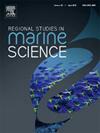Microplastic pollution in marine bivalves, surface water and sediments from an aquaculture in Portugal and possible intake by humans
IF 2.1
4区 环境科学与生态学
Q3 ECOLOGY
引用次数: 0
Abstract
The abundance and types of microplastics (MP) were assessed in different tissues of Magallana gigas (diploid and triploid oysters) and Ruditapes philippinarum (clams), surface water and sediments in a Portuguese shellfish farm. The daily MP intake by humans through the consumption of these organisms was estimated. Diploid oysters (0.33–5.00 MP particles/tissues) and clams (0.00–3.33 MP particles/tissues) showed higher MP abundances than triploid oysters (0.00–1.00 MP particles/tissues). Seasonal differences in MP abundance were observed in diploid oysters (visceral mass: winter lower than autumn, spring and summer; digestive gland: autumn and winter lower than summer; gills: autumn, spring and summer lower than winter), triploid oysters (gills: summer lower than autumn) and clams (digestive gland and gills: autumn, winter and summer lower than spring; foot: autumn lower than spring and summer). The highest MP abundances were observed in the visceral mass (5.00 MP particles/tissue in diploid oysters), digestive gland (3.33 MP particles/tissue in clams) and gills (1.00 MP particles/tissue in triploid oysters). Pink MP films (1–100 µm) were predominantly found in these bivalves. MPs were detected in surface water (0.00–5.33 MP particles/L) and sediments (15.47–114.55 MP particles/kg). Temporal variations in MP abundance were observed in surface water (low tide: Oct19, Nov19, Jan20, Feb20, Mar20, Aug20 and Sep20 lower than Sep19 and Dec19; high tide: Nov19 lower than Dec19, Ap20 and May20) and sediments (low tide: Sep19, Oct19, Jan20, Jun20, Jul20, Aug20 and Sep20 lower than Dec19 and Apr20). Tidal variations were detected in sediments (Nov19, Dec19 and May20: high tide lower than low tide). MPs in surface water were predominantly transparent fibers (100–2500 µm), while those observed in sediments were blue fragments (100–2500 µm). The main polymers identified were poly(propylene) and poly(ethylene). The highest daily MP intake values were observed in adults, very elderly and pregnant women.
求助全文
约1分钟内获得全文
求助全文
来源期刊

Regional Studies in Marine Science
Agricultural and Biological Sciences-Ecology, Evolution, Behavior and Systematics
CiteScore
3.90
自引率
4.80%
发文量
336
审稿时长
69 days
期刊介绍:
REGIONAL STUDIES IN MARINE SCIENCE will publish scientifically sound papers on regional aspects of maritime and marine resources in estuaries, coastal zones, continental shelf, the seas and oceans.
 求助内容:
求助内容: 应助结果提醒方式:
应助结果提醒方式:


